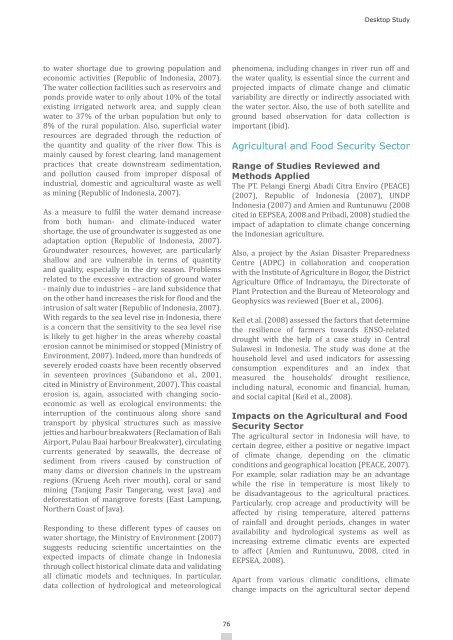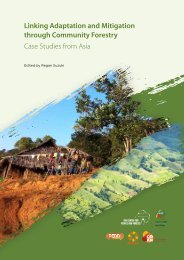Desktop Study on - Regional Climate Change Adaptation ...
Desktop Study on - Regional Climate Change Adaptation ...
Desktop Study on - Regional Climate Change Adaptation ...
Create successful ePaper yourself
Turn your PDF publications into a flip-book with our unique Google optimized e-Paper software.
<str<strong>on</strong>g>Desktop</str<strong>on</strong>g> <str<strong>on</strong>g>Study</str<strong>on</strong>g><br />
to water shortage due to growing populati<strong>on</strong> and<br />
ec<strong>on</strong>omic activities (Republic of Ind<strong>on</strong>esia, 2007).<br />
The water collecti<strong>on</strong> facilities such as reservoirs and<br />
p<strong>on</strong>ds provide water to <strong>on</strong>ly about 10% of the total<br />
existing irrigated network area, and supply clean<br />
water to 37% of the urban populati<strong>on</strong> but <strong>on</strong>ly to<br />
8% of the rural populati<strong>on</strong>. Also, superficial water<br />
resources are degraded through the reducti<strong>on</strong> of<br />
the quantity and quality of the river flow. This is<br />
mainly caused by forest clearing, land management<br />
practices that create downstream sedimentati<strong>on</strong>,<br />
and polluti<strong>on</strong> caused from improper disposal of<br />
industrial, domestic and agricultural waste as well<br />
as mining (Republic of Ind<strong>on</strong>esia, 2007).<br />
As a measure to fulfil the water demand increase<br />
from both human- and climate-induced water<br />
shortage, the use of groundwater is suggested as <strong>on</strong>e<br />
adaptati<strong>on</strong> opti<strong>on</strong> (Republic of Ind<strong>on</strong>esia, 2007).<br />
Groundwater resources, however, are particularly<br />
shallow and are vulnerable in terms of quantity<br />
and quality, especially in the dry seas<strong>on</strong>. Problems<br />
related to the excessive extracti<strong>on</strong> of ground water<br />
- mainly due to industries – are land subsidence that<br />
<strong>on</strong> the other hand increases the risk for flood and the<br />
intrusi<strong>on</strong> of salt water (Republic of Ind<strong>on</strong>esia, 2007).<br />
With regards to the sea level rise in Ind<strong>on</strong>esia, there<br />
is a c<strong>on</strong>cern that the sensitivity to the sea level rise<br />
is likely to get higher in the areas whereby coastal<br />
erosi<strong>on</strong> cannot be minimised or stopped (Ministry of<br />
Envir<strong>on</strong>ment, 2007). Indeed, more than hundreds of<br />
severely eroded coasts have been recently observed<br />
in seventeen provinces (Suband<strong>on</strong>o et al., 2001,<br />
cited in Ministry of Envir<strong>on</strong>ment, 2007). This coastal<br />
erosi<strong>on</strong> is, again, associated with changing socioec<strong>on</strong>omic<br />
as well as ecological envir<strong>on</strong>ments: the<br />
interrupti<strong>on</strong> of the c<strong>on</strong>tinuous al<strong>on</strong>g shore sand<br />
transport by physical structures such as massive<br />
jetties and harbour breakwaters (Reclamati<strong>on</strong> of Bali<br />
Airport, Pulau Baai harbour Breakwater), circulating<br />
currents generated by seawalls, the decrease of<br />
sediment from rivers caused by c<strong>on</strong>structi<strong>on</strong> of<br />
many dams or diversi<strong>on</strong> channels in the upstream<br />
regi<strong>on</strong>s (Krueng Aceh river mouth), coral or sand<br />
mining (Tanjung Pasir Tangerang, west Java) and<br />
deforestati<strong>on</strong> of mangrove forests (East Lampung,<br />
Northern Coast of Java).<br />
Resp<strong>on</strong>ding to these different types of causes <strong>on</strong><br />
water shortage, the Ministry of Envir<strong>on</strong>ment (2007)<br />
suggests reducing scientific uncertainties <strong>on</strong> the<br />
expected impacts of climate change in Ind<strong>on</strong>esia<br />
through collect historical climate data and validating<br />
all climatic models and techniques. In particular,<br />
data collecti<strong>on</strong> of hydrological and meteorological<br />
phenomena, including changes in river run off and<br />
the water quality, is essential since the current and<br />
projected impacts of climate change and climatic<br />
variability are directly or indirectly associated with<br />
the water sector. Also, the use of both satellite and<br />
ground based observati<strong>on</strong> for data collecti<strong>on</strong> is<br />
important (ibid).<br />
Agricultural and Food Security Sector<br />
Range of Studies Reviewed and<br />
Methods Applied<br />
The PT. Pelangi Energi Abadi Citra Enviro (PEACE)<br />
(2007), Republic of Ind<strong>on</strong>esia (2007), UNDP<br />
Ind<strong>on</strong>esia (2007) and Amien and Runtunuwu (2008<br />
cited in EEPSEA, 2008 and Pribadi, 2008) studied the<br />
impact of adaptati<strong>on</strong> to climate change c<strong>on</strong>cerning<br />
the Ind<strong>on</strong>esian agriculture.<br />
Also, a project by the Asian Disaster Preparedness<br />
Centre (ADPC) in collaborati<strong>on</strong> and cooperati<strong>on</strong><br />
with the Institute of Agriculture in Bogor, the District<br />
Agriculture Office of Indramayu, the Directorate of<br />
Plant Protecti<strong>on</strong> and the Bureau of Meteorology and<br />
Geophysics was reviewed (Boer et al., 2006).<br />
Keil et al. (2008) assessed the factors that determine<br />
the resilience of farmers towards ENSO-related<br />
drought with the help of a case study in Central<br />
Sulawesi in Ind<strong>on</strong>esia. The study was d<strong>on</strong>e at the<br />
household level and used indicators for assessing<br />
c<strong>on</strong>sumpti<strong>on</strong> expenditures and an index that<br />
measured the households’ drought resilience,<br />
including natural, ec<strong>on</strong>omic and financial, human,<br />
and social capital (Keil et al., 2008).<br />
Impacts <strong>on</strong> the Agricultural and Food<br />
Security Sector<br />
The agricultural sector in Ind<strong>on</strong>esia will have, to<br />
certain degree, either a positive or negative impact<br />
of climate change, depending <strong>on</strong> the climatic<br />
c<strong>on</strong>diti<strong>on</strong>s and geographical locati<strong>on</strong> (PEACE, 2007).<br />
For example, solar radiati<strong>on</strong> may be an advantage<br />
while the rise in temperature is most likely to<br />
be disadvantageous to the agricultural practices.<br />
Particularly, crop acreage and productivity will be<br />
affected by rising temperature, altered patterns<br />
of rainfall and drought periods, changes in water<br />
availability and hydrological systems as well as<br />
increasing extreme climatic events are expected<br />
to affect (Amien and Runtunuwu, 2008, cited in<br />
EEPSEA, 2008).<br />
Apart from various climatic c<strong>on</strong>diti<strong>on</strong>s, climate<br />
change impacts <strong>on</strong> the agricultural sector depend<br />
76

















